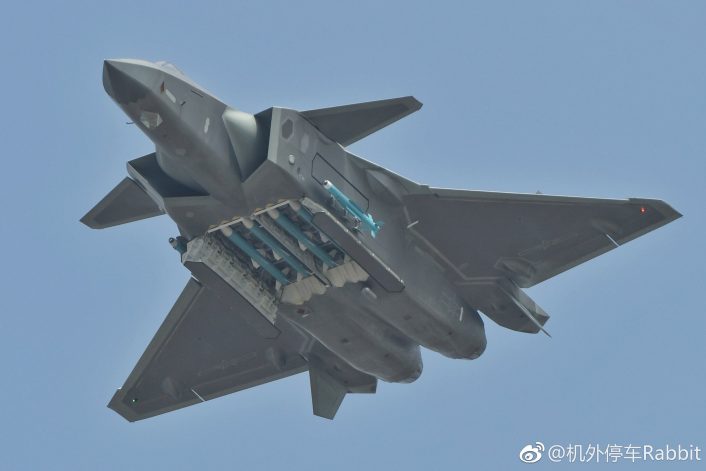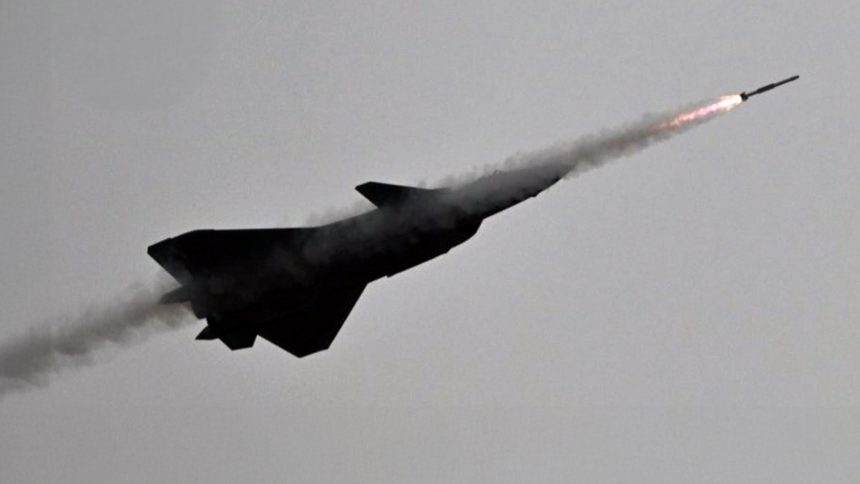The side internal weapons bays are designed to house the PL-10 short-range air-to-air missile. Additionally, the J-20’s bay mechanics and internal design showcase a fascinating integration of engineering precision and tactical air combat functionality, highlighting how these aspects influence and complement each other.
The first clear image of a PLA Air Force J-20 stealth fighter firing a PL-10 short-range AAM (Air-to-Air Missile) has emerged. The missile is seen leaving the right-side internal weapons bay of the aircraft in the image, that bears the logo of the PLA Air Force and appears to have been first posted on the PLAAF’s official Weibo account.
This follows a very short one-second clip that surfaced online in Nov. 2023, that showed a missile leaving the same side of the jet in a similar fashion, and also bore the logo of the Chinese military’s publicity wing and the “new” image may well be just a screenshot from the previous clip.
While it is highly unlikely that the J-20 will not have undertaken live weapons firing prior to this, and that this being only one of the rare moments it has been captured on camera, it is interesting to see the secretive jet in action.
As such, it is near impossible to know the specific tactical situation in which the PL-10 was fired, or if there was a pilotless target drone involved. Its American counterparts, the F-35 and the F-22 meanwhile have frequently been clicked and recorded in weapons firings, mostly by its own media-friendly military.
If I’m not mistaken, then is this the first clear image showing a J-20 launching a PL-10 AAM.
(Image via PLAAF / @人民空军 from Weibo) pic.twitter.com/fyqamTwf8s
— @Rupprecht_A (@RupprechtDeino) November 27, 2024
Image and identity of the missile
The latest image was shared by leading Chinese military aviation researcher Andreas Rupprecht. While the missile is easily identifiable in the current image, the clip from Nov. 2023 is grainy. Yet it can be confirmed to be the missile for the simple reason that the side internal weapons bays are meant to house the short and medium-range AAMs like the PL-10. Moreover, both the video and image clearly shows the trajectory of the smoke streak tracing itself to the side bay, implying the missile has to be the PL-10.
It cannot be the PL-15 since it would be too large to fit inside the side weapons bay. The PL-15 BVR (Beyond Visual Range) AAM – whose rumored 300 km range is said to have spurred the development of the AIM-250 JATM (Joint Advanced Tactical Missile) – is first dropped from the underbelly concealed weapons bays, following which the motor ignites. That section carries four PL-15s, two in each of the compartments, exactly under the engine nacelles. The PL-10 meanwhile is launched off the rails.
Whether the latest image is a clearer captured still of the Nov. 2023 video only being released now, or a different picture altogether from a separate exercise, is not clear. And the Chinese military almost never delves into weapons specifications in their publicity material, except for pictures and videos. In both situations, the J-20 appears to be flying in level flight.
First ever footage of J-20 launching PL-10 and also AAR 👀 pic.twitter.com/65bQaaeNrK
— Húrin (@Hurin92) November 10, 2023
J-20 design and dogfighting
It is also warranted to look at the interesting mechanics of the J-20’s internal bay functions and designs, and how both the engineering and air combat tactics feed into each other. One has to go back to the 2018 Zhuhai Air Show when the J-20 first opened up its underbelly and side weapons bays while flying overhead, displaying its full payload. The ventral stores showed the PL-15s. But it was the arrangement of the side bays that showed some fascinating techno-tactical thinking.
The bay showed a mechanism where rounded semi-circular launcher rails rolled out carrying a missile, but the bay door remained closed. The F-22’s and the F-35’s side weapons hold outside the engine intakes meanwhile has the launcher rail in a retracted position. It is pushed out in an extending-out motion, and comes to a stop almost in a diagonal position. The F-35 meanwhile has the launching rails both on the inside of the weapons bay and on the inside of the opening bay doors. On a different note, the J-20’s weapons bay also looks less engineered and less cluttered than the F-35 and the F-22.

The launcher-carriage-bay door arrangement on the J-20 translates into a mechanism where the door opens and the launcher rolls out with the missile, with the door immediately closing again. In a dogfight, where stealth is not a priority, the pilot can keep the missile ready with a launcher extended before releasing the possibly high off-boresight LOAL (Lock-On After-Launch) PL-10. There are differing claims on the PL-10’s guidance. A November 2020 report by the CASI (China Aerospace Studies Institute) says it has an IR (Infra-Red) seeker that can be slaved to an helmet-mounted cueing system.
If stealth is a concern where the pilot expects to be targeted by BVR missiles while being in a dogfight, he can quickly open the bay doors and release the missiles. This is because opening and keeping the bay doors open provides an added reflective surface – although it would be questionable to how much the few seconds of radar visibility might make a difference.
J-20s with the homegrown supercruise capable WS-15 engine, with thrust-vectoring nozzles might achieve the sharp performance required for the tight, high-G maneuvers. This is because earlier footage of its flights had shown plain flypasts. This had led to a conclusion that the jet, although influenced by the F-35, was meant more as an airborne sniper. Using stealth and jamming, it would slip through enemy fighter screens and take out vulnerable support aircraft like refueling tankers and AWACS.
Only time will tell how the jet will be employed and perform.
🇨🇳J-20 stealth fighter with (at least) two PL-15 missiles in the (open) bay plus (at least) one extra PL-10 missile externally deployed, ID N° (7?)8233
(via wb/菜鸟耶夫斯基) pic.twitter.com/lyGmVnoIHW
— Jesus Roman (@jesusfroman) July 31, 2022
Significance
Moreover, it also comes close on the heels of the twin-seat version of the J-20, the J-20S, being officially unveiled at the recently concluded Zhuhai Air Show. That variant had been spotted in a factory yellow paint scheme in August 2022, and some assessments believe it to be more suited for controlling wingmen and collaborative drones/UCAVs. The rear-seated pilot WSO (Weapons Systems Operator) would undertake that responsibility, along with the more advanced EW (Electronic Warfare) functions.
Screen grabs from a digital representation on CCTV (China Central Television) that showed a J-20 flying with three wingmen UCAVs that were identified as GJ-11s, suggest a slightly longer cockpit, suggesting a twin-seat variant.
This makes the J-20 the first fifth-generation, dual-seat stealth fighter. It is also possible that the J-20S variant, by the time it reaches serial production, would be flying with China’s indigenously developed WS-15s. But these are expectant developments with Chinese military aviation, given how it has purposely built its aircraft and aircraft factories to not repeat some mistakes of America’s defense industry.
To those unfamiliar:
PL-10 is a HOBS ImIR guided SRAAM. True range unknown, but export range is 20km. On J-20 is likely paired with known HMDS.
PL-15 is BVRAAM, likely w/ dual pulse motor (greater range+end game pK) with possible AESA seeker. Range thought to approach 200km. pic.twitter.com/uUM9LqGX7h
— Rick Joe (@RickJoe_PLA) November 11, 2018
Neither of the U.S. fighters are being produced at the scale the J-20 is being churned out.









